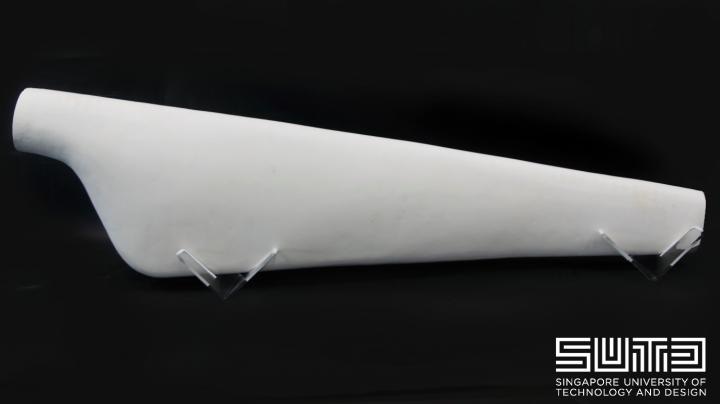Jun 7 2018
One of the most plentiful and widely distributed organic compound and industrial by-product on Earth is cellulose. Yet, in spite of years of wide-ranging research, the bottom-up use of cellulose to make 3D objects is still afflicted with issues that limit its practical applications: by-products with massive polluting effects, high production cost, used in combination with plastics, and lack of scalability.
 1.2 m, 5.2 kg turbine blade fabricated entirely with cellulose and chitosan, the most ubiquitous biopolymers on earth and produced in large amounts in almost every ecosystem. Both ingredients are obtained from by-products of the industry, resulting in production with negative ecological footprint. (Image credit: SUTD)
1.2 m, 5.2 kg turbine blade fabricated entirely with cellulose and chitosan, the most ubiquitous biopolymers on earth and produced in large amounts in almost every ecosystem. Both ingredients are obtained from by-products of the industry, resulting in production with negative ecological footprint. (Image credit: SUTD)
However, scientists from the Singapore University of Technology and Design (SUTD) have recently shown the use of cellulose to sustainably produce/fabricate large 3D objects. Their technique deviates from the common association of cellulose with green plants and is enthused by the wall of the fungus-like oomycetes, which is reproduced by adding small quantities of chitin between cellulose fibers. The resulting fungal-like adhesive material(s) (FLAM) are robust, inexpensive, and lightweight, and can be processed or molded using woodworking methods.
This material is totally ecologically sustainable as no synthetic plastics or organic solvents were used to make it. It is scalable and can be reproduced anywhere without dedicated facilities. FLAM is also completely biodegradable in natural conditions and outside composting plants. The FLAM’s cost is in the range of commodity plastics and 10 times lower than the cost of regular filaments for 3D printing, such as ABS (Acrylonitrile Butadiene Styrene) and PLA (polylactic acid), making it not only more sustainable but also a more economical substitute. The scientists have additionally created an additive manufacturing method mainly for the material.
We believe this first large-scale additive manufacturing process with the most ubiquitous biological polymers on earth will be the catalyst for the transition to environmentally benign and circular manufacturing models, where materials are produced, used, and degraded in closed regional systems. This reproduction and manufacturing with the material composition found in the oomycete wall, namely unmodified cellulose, small amounts of chitosan—the second most abundant organic molecule on earth—and low concentrated acetic acid, is probably one of the most successful technological achievements in the field of bio-inspired materials.
Javier Gomez Fernandez, Co-Lead and SUTD Assistant Professor
We believe the results reported here represent a turning point for global manufacturing with broader impact on multiple areas ranging from material science, environmental engineering, automation and the economy. So far we have been focusing on fundamental technology development, and little time has been invested in specific target applications. We are now at the stage of seeking industrial collaborators to bring this technology from the laboratory to the world.
Stylianos Dritsas, Co-Lead & SUTD Assistant Professor
With the increase in pollution and waste, the necessity for more sustainable manufacturing methods is increasing. The formation of a technology based on unmodified compostable polymers of huge abundance that does not require forest resources or cropland, will foster the evolution of environmentally favorable manufacturing and a sustainable world.
This study was reported in the June 5th edition of the Scientific Reports journal.